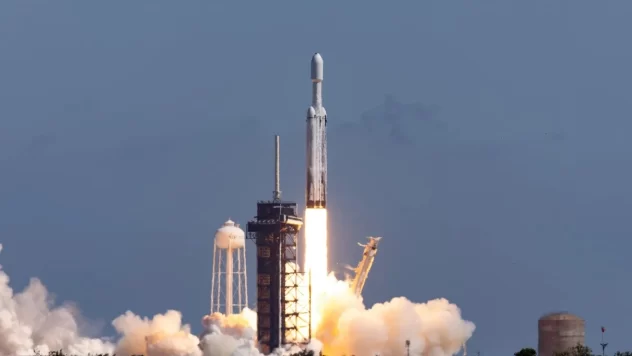The launch of Europa Clipper has been a complete success. The ship has taken off on board a SpaceX Falcon Heavy rocket. It now begins a long journey to Europa, the intriguing satellite of Jupiter. Its ambitious mission is to help understand what this satellite is like, which could harbour life beneath its frozen surface.
At 18:06 in the afternoon in Spanish peninsular time, a Falcon Heavy rocket took off from the Kennedy Space Center, in Cape Canaveral. The takeoff took place from platform 39A. One of the most interesting aspects of this mission is that none of the three components of the Falcon Heavy rocket were recovered. On this occasion, it was necessary to use the power of all its engines to be able to reach the trajectory necessary for Europa Clipper to reach its destination. The launch itself was different from others we have observed.
Three minutes after liftoff, the two booster rockets separated from the core rocket. The core stage was responsible for providing thrust for another minute. Four minutes after launch, the core stage separated. None of the three stages were recovered by SpaceX, as had been explained before the launch. This is new because in previous Falcon Heavy launches, although the core stage had not been recovered, the booster stages had been.
58 minutes after lift-off, Europa Clipper finally separated from the second stage. It was one of the most eagerly awaited moments of the launch. The rocket has put the spacecraft on a trajectory that will allow it, in a few years, to reach its destination in the vicinity of Jupiter . Minutes after separation, the mission team managed to establish contact with the probe. This first contact has allowed them to verify that the spacecraft’s systems are in good condition, except for a small anomaly that has not affected the operation of the probe.
Specifically, the team had seen a small anomaly in the propulsion system. But moments later they explained that it was not something that affected the performance of the ship, which was behaving as expected. Now, the next big step for Europa Clipper is the deployment of its solar panels, which will take place six hours after launch. This has not yet happened at the time of writing this article. It will be a critical moment because Europa Clipper will depend on those solar panels to be able to carry out its mission.
The launch has been delayed by four days from the original date of October 10, due to the impact of Hurricane Milton, which hit the coast of Florida on October 9. So much so that NASA had to close the Kennedy Space Center. As part of the precautionary measures, Europa Clipper was stored in a SpaceX hangar. Although this is the eleventh launch of a Falcon Heavy rocket, it is only the second time it has been used for an interplanetary mission. The two auxiliary rockets have already been used on the Psyche probe mission .
It is the largest and heaviest spacecraft ever built by NASA. At launch it weighed 6,000 kg. With its panels extended it will be about 30 metres long. That is, more than a basketball court. The enormous size of the solar panels is explained by the fact that in Jupiter’s orbit the amount of energy that can be collected from the Sun is much less than what we can obtain with solar panels from the Earth’s environment. Now a long journey begins until the probe reaches its destination in 2030, and it will have a lot of work ahead of it.
If all goes well, Europa Clipper will enter orbit around Jupiter in April of that year. Once there, it will fire its engines for six to eight hours to be able to enter orbit around the planet. It will use up between 50 and 60% of the more than 2,700 kg of fuel it carries on board. This will put it into an elliptical orbit around the Jovian giant. Afterwards, a series of manoeuvres will modify its trajectory so that it can study Europa up close during 45 flybys. That is to say, although it will study Europa, the mission will be in orbit around Jupiter.
The reason is that an orbit around Europa would have been too dangerous. The amount of radiation in its environment is too high for the spacecraft. The first flyby of Europa is planned for spring 2031. It will be used to correct the probe’s course if necessary, in preparation for the start of the Europa Clipper scientific campaign. A series of flybys will begin in May 2031 to help understand what the hemisphere facing away from Jupiter is like.
It will come within just 25 km of the surface. Two years later, in May 2033, the second part of the scientific campaign will begin, this time focusing on the hemisphere facing the planet. The mission is scheduled to end in September 2034. The aim is for the spacecraft to crash into the surface of Ganymede. This was chosen because Ganymede is not considered to be a particularly hospitable place for life. The mission team wants to prevent Europa from being contaminated by possible terrestrial microbes in this way.

